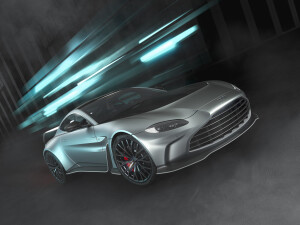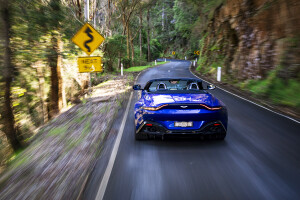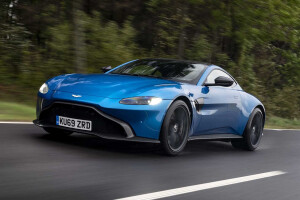Latest Review

2022 Aston Martin Vantage F1 Edition review: Australian first drive
Aston Martin's Vantage finally finds its teeth
Aston Martin Lagonda is extremely keen for you to make a link between its classic British branding and the pinnacle of motorsport, Formula 1. This is no easy feat. For a start, the marque recently “returned” to the sport as a manufacturer in 2021, replacing the awful Racing Point name.
Returned is slightly sarcastic. There was an ill-fated Aston Martin Formula 1 operation in 1959 and 1960. And embarrassing because the sports car team won Le Mans in the same year as its grand prix debut. Aston wisely withdrew to concentrate on that instead.
For 2021, the team hired Sebastian Vettel fresh from a scrappy stint at Scuderia Ferrari. Also coincidental was the gradual replacement of AMG cars as Formula 1’s official safety and medical car vehicles with Aston Martin’s Vantage and DBX respectively. In 2022, the change is complete.
And as if to really hammer home the point, the day I picked up the Vantage F1 Edition was the same day the Aston Martin AMR22 made its global debut ahead of the Formula 1 season. It’s F1, everywhere, all the time.
If you’re going to spend shareholder money putting yourself in front of a global audience boosted by Lewis Hamilton and Max Verstappen’s title fight and the attendant melodrama provided by Netflix’s Drive to Survive (which can string out a fender bender for fifteen minutes), you want to be able to put your expensive association with F1 on the road.
Which brings us to the Vantage F1 Edition. The name isn’t a very imaginative start and neither are the tacky-looking badges embedded in the grilles on the front guards and glued to the interior. Thankfully, that’s as bad as it gets.
The car’s elegant exterior is now much more aggressive. Carbon inserts on the massive bonnet extract air from under the bonnet while further carbon appears on the guards funnelling air out from the wheel wells to reduce pressure.
A giant wing sits proud of the boot deck, working in concert with the substantial chin spoiler and fussy aero devices at the front corners, all finished in gloss black. The aero works, too, turning the standard car’s front lift into downforce and further squishing the rear into the ground for real downforce at the car’s top speed of 316km/h.
The huge Aston grille is blacked out for extra menace while the rear diffuser is the same, the darkened exhaust pipes sticking through and providing a sensible soundtrack.
The cabin echoes some of the design features of the race car, with a yellow stripe along the Alcantara clad doors. Further application of Alcantara ensures a cosy, race cockpit feel even if the seats themselves aren’t exactly super-sporty but hold you in just fine.
Aston has restrained itself inside and out and while it’s obvious this is something special, the company didn’t go overboard.
Except with the buttons. There are so many buttons in this interior that are identical that it’s very difficult to memorise which is which and more difficult still to identify them by touch. The car’s ancillary controls are tightly packed but not well grouped, so the traction control button is marooned amongst other less important functions.
Further ergonomic woes can be found on the steering column. While there is no stalk on the right-hand side, three are crammed on the left – indicator/wiper combination, cruise control and adjustment for the column itself – and all stand in the way of the lovely fixed downshift paddle.
The dash and console is made of really dark plastic that wouldn’t look out of place in a Mazda, which is to sledge neither brand but you kind of want something a bit more than plastic air vents when you’ve laid down north of three hundred large. The tiny media screen is straight from an elderly A-Class and has the software to match. It’s clunky and cranky to use and features neither Apple CarPlay nor Android Auto.
The weirdly shaped steering wheel carries over, but again has Alcantara trim to make it lovely to the touch.
Inside and out, it’s still an Aston Martin, with more of an eye in the general direction of the race track rather than firmly planted on it. Which is a play on how it handles, because there are significant differences between this edition and the car on which it’s based.
Aston’s CEO, Tobias Moers, had a very simple brief for this car – it needed to be faster on the track (the Nürburgring, obviously) but it had to be done properly. He didn’t want a set of super-sticky tyres slapped on to knock off a few seconds, the results had to come from actual engineering.
Easier said than done. The standard Vantage is famous for being a little wayward at the rear, the suspension not always keeping things as straight and true as you might want, at least on the road.
The F1 Edition features a number of engineering changes to reduce the amount of inputs the rear end has to cope with. The springs are firmer by 10 per cent and the compression damping 20 per cent. Perhaps the most significant change is the way the eight-speed ZF transaxle is fixed in place. With less lateral movement, the rear becomes more stable and predictable with the clear benefit of inspiring more confidence and keeping the tyres in contact with the tarmac.
Similarly, the steering column is now more firmly fixed in place to reduce the intended compliance of a normal Vantage. The springs are the same but the bump stops are stiffer and the dampers’ low-speed rebound is 30 per cent higher.
On paper that sounds like the Vantage has become a hard-riding monster, but the reality is nothing of the sort. It’s a perfectly reasonable car in which to spend a long day on freeways and funways (and I did) and step out with jimmies completely unrustled.
The unrustling is more impressive given the Vantage rolls on attractive and massive 21-inch alloys shod in Pirelli P-Zero rubber. Matt Becker’s engineering team looked at a custom compound but found the standard tyre with its shallower sidewall and the stiffened front end was more than enough of an improvement.
You can feel the car’s agility just steering out of a car park. The nose takes orders and executes without any slack, the direction change near-instant and without the feeling of hauling well over a tonne-and-a-half along with you. As you build speed that response remains but never unsettles the car in either tightening corners or abrupt direction changes.
The steering itself is light but chatty. It’s heavier than the standard car due to the combination of changes but it’s never a chore, even in the highest of the three settings, Track. In keeping with its sporting intent, there is no Comfort or Normal – Sport is where you start.
Becker’s team wisely separated the modes from the adaptive suspension settings. The ride is excellent in Sport, edgy in Sport+ and A Bit Much in Track setting, at least for the road which is where I spent all my time. Either of the other two suited my route on the western side of the Blue Mountains on bumpy, truck-rutted rural roads.
I’m quite happy to put my hand up and say that I rarely disable or even loosen electronic aids on the road in cars like this. Sometimes it’s because they’re extremely well-calibrated, like the Vantage’s logical rival, the Porsche 911. Sometimes it’s through fear of the results, but once I found the traction control button, I hit it because the confidence I had in this car to push it and myself came quickly. But also because the calibration was far too cautious, I had to see what it was like unleashed.
It really is glorious. With the drivetrain set to Track and the suspension to Sport + to save my delicate spine, this is the kind of car that you just know will carry you through the corners and fire you out the other side with a crack and a whoop.
While power is “only” up a few kilowatts to 393kW and torque identical, the delivery is different. The software changes have broadened the rev range where that planet-splitting 685Nm is available between 2000 and 5000 rpm. The subtly recalibrated eight-speed ZF transaxle goes from its usual immensely capable and unobtrusive self to a far crisper shifting unit that feels almost, but not quite, like a twin-clutch, enhancing the car’s character instead of narrowing it.
Aston has done a better job than BMW in its more aggressive mode. The ZF is an always-excellent transmission and it’s a joy to use via the blacked-out alloy paddles. It’s much more willing to give you a gear as you’re downshifting. Hold the paddle to get the lowest gear available or play with it to see whether you really do need that lower gear, such is the surfeit of twist.
One thing you do have to get used to is how to rotate the F1 Edition in the corners. The active differential is fairly benign as you reduce the brake pressure on turn-in, clearly not wanting to second-guess what you want to do next. The result is a fine balance between neutrality and the mildest of safety-focused understeer on corner entry. As soon as you get on the throttle, however, the nose comes back to life and darts for the apex without upsetting your steering input.
You get so much communication through the wheel and the seat that you can alter your line whichever way you like. The differential really ties it all together, taking the substantial benefits of the subtle changes and weaving it into a fast, planted road car. I’ve no doubt of its track potential but its on-road abilities take it really close to a 911 while also delivering the character of a front-mid engined car that is resolutely rear-wheel drive.
What’s most surprising is that the changes have calmed its behaviour in the bumpy stuff, leaving you to get on with the business of hunting down the next bend rather than worrying about having to bring it into line or feel like you’re about to be spat off the road.
You can choose carbon-ceramic brakes but the standard cast-iron steel brakes measure a whopping 400mm up front and 360mm at the rear. Pedal feel is close to perfection for a road car and easy to modulate. Less easy to operate is the auto parking brake which insists on making you look at goose when you’re exiting a car park.
Moers’ direction to Becker was a masterstroke. While the public remaking of its image is aimed at introducing a Netflix-driven F1-watching younger generation to a brand that has struggled to penetrate its consciousness, the road cars are still elegant, refined and fast.
The F1 Edition feels like a precursor to the entire range upgrade, an experiment in fine chassis tuning to deliver a better driving experience without resorting to sledgehammer power figures or semi-slick tyres. It’s compliant, adjustable, gorgeous and engaging. It doesn’t bend physics like a 911 GT3 or wrestle the driver into a particular way of doing things but instead works with you.
Sports cars can be a chore most of the time and brilliant some of the time. The Vantage F1 Edition doesn’t trade away its usability but enhances it with a sharper dynamic edge. That’s the kind of engineering excellence drivers want, whether it’s you, me or Sebastian Vettel.
Aston Martin Vantage F1 Edition specs
Things we like
- Liveable performance
- Looks not destroyed by aero
- Sparkling chassis
Not so much
- Tacky badging
- Underwhelming interior (apart from the seats)
News
-
 News
NewsAston Martin unveils 515kW V12 Vantage Roadster
British carmaker lifts the lid on most powerful Vantage roadster ever
-
 News
News2022 Aston Martin V12 Vantage revealed, limited to 333 units
The final-ever V12 Vantage packs a big punch – but it’ll be limited to 333 units, which have already sold out
-
 News
News2022 Aston Martin V12 Vantage reveal date set
New Vantage will be a V12 swansong before electrification strategy kicks in
-
 News
NewsEx-Rowan Atkinson-raced Aston Martin Vantage Zagato for sale
Ultra rare Zagato expected to sell for a tidy price
-

Aston Martin teases return of the V12 Vantage for a Final Edition farewell
-

2021 Aston Martin Vantage Roadster review: Car vs road
-

There is more to the Aston Martin Vantage Roadster than meets the eye
-

Manual transmission officially dropped from Aston Martin range in Australia







